bonnet Hyundai Terracan 2003 Owner's Manual
[x] Cancel search | Manufacturer: HYUNDAI, Model Year: 2003, Model line: Terracan, Model: Hyundai Terracan 2003Pages: 349, PDF Size: 4.56 MB
Page 201 of 349

CONTROLS AND EQUIPMENT1- 7
B070A01A-EAT THEFT-ALARM SYSTEM (Not all models) This system is designed to provide protection
from unauthorized entry into the car. This sys- tem is operated in three stages: the first is the"Armed" stage, the second is the "Alarm" stage,and the third is the "Disarmed" stage. If trig-gered, the system provides an audible alarmwith blinking of turn signal lights.
B070B01O-EAT Armed Stage
B070B02HP.DAG
Park the car and stop the engine. Arm the
system as described below.
UNLOCK LOCK
B040G01HP-AAT Central Door Locks (Not all models)
The central door locking switch is located on
the driver's arm rest. It is operated by depress- ing the door lock switch. If any door is openwhen the switch is depressed, the door willremain locked when closed.
NOTE:
o When pushing the front portion of the driver's door lock switch, all vehicle doorswill lock.
o When pushing the rear portion of the switch, all vehicle doors will unlock.
o The central door locking is operated by turning the key toward the front or rearof the vehicle.
B040G01HP.DAG 1) Remove the ignition key from the ignition
switch.
2) Make sure that the bonnet and hatchback door are closed.
3) Lock the doors using the transmitter of the keyless entry system.
After completion of the steps above, the turn
signal lights will blink once to indicate that the system is armed
NOTE:
1) If any door, hatchback door or engine bonnet remains open, the system will notbe armed.
2) If this happens, rearm the system as described above.
CAUTION:Do not arm the system until all passengers
have left the car. If the system is armedwhilst a passenger(s) remains in the car, thealarm may be activated when the remainingpassenger(s) leaves the car.
LOCK
UNLOCK
Page 202 of 349
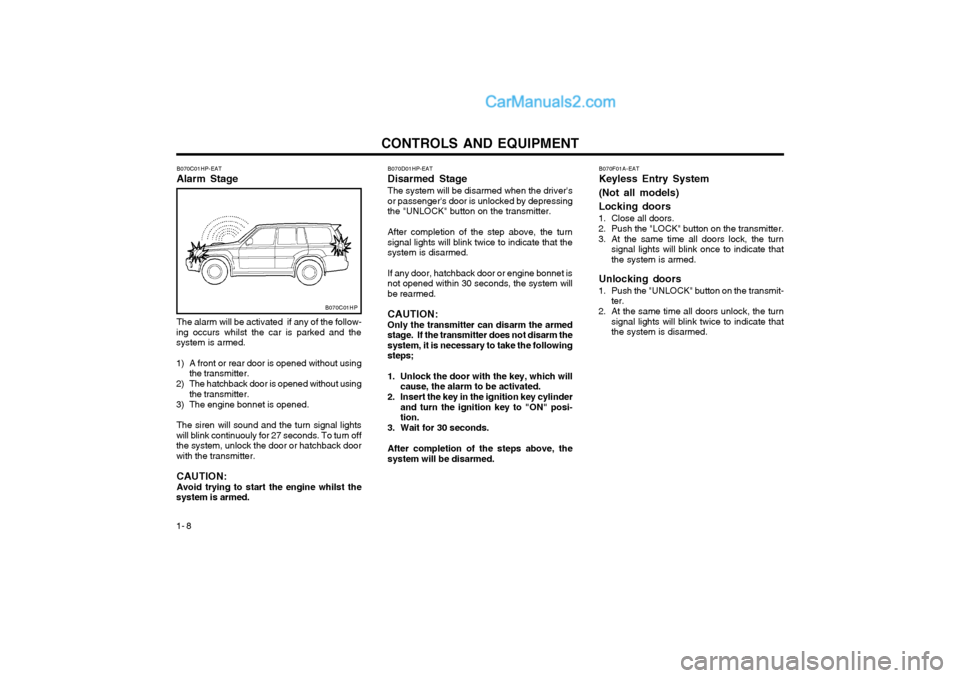
CONTROLS AND EQUIPMENT
1- 8
B070D01HP-EAT Disarmed StageThe system will be disarmed when the driver's or passenger's door is unlocked by depressingthe "UNLOCK" button on the transmitter. After completion of the step above, the turn signal lights will blink twice to indicate that thesystem is disarmed. If any door, hatchback door or engine bonnet is not opened within 30 seconds, the system willbe rearmed. CAUTION: Only the transmitter can disarm the armed stage. If the transmitter does not disarm thesystem, it is necessary to take the followingsteps;
1. Unlock the door with the key, which will cause, the alarm to be activated.
2. Insert the key in the ignition key cylinder and turn the ignition key to "ON" posi- tion.
3. Wait for 30 seconds. After completion of the steps above, the system will be disarmed.
B070C01HP-EAT Alarm Stage
B070F01A-EATKeyless Entry System (Not all models) Locking doors
1. Close all doors.
2. Push the "LOCK" button on the transmitter.
3. At the same time all doors lock, the turn signal lights will blink once to indicate that the system is armed.
Unlocking doors
1. Push the "UNLOCK" button on the transmit- ter.
2. At the same time all doors unlock, the turn signal lights will blink twice to indicate thatthe system is disarmed.
B070C01HP
The alarm will be activated if any of the follow-
ing occurs whilst the car is parked and the system is armed.
1) A front or rear door is opened without using the transmitter.
2) The hatchback door is opened without using the transmitter.
3) The engine bonnet is opened.
The siren will sound and the turn signal lights
will blink continuouly for 27 seconds. To turn off the system, unlock the door or hatchback doorwith the transmitter.
CAUTION: Avoid trying to start the engine whilst the
system is armed.
Page 224 of 349
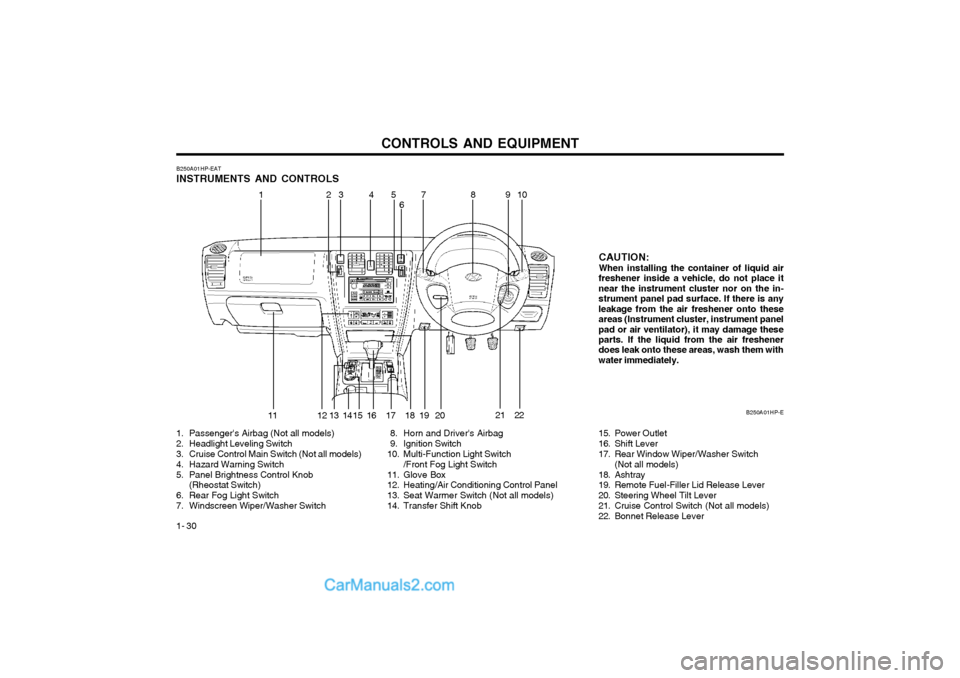
CONTROLS AND EQUIPMENT
1- 30
B250A01HP-EAT INSTRUMENTS AND CONTROLS
1. Passenger's Airbag (Not all models)
2. Headlight Leveling Switch
3. Cruise Control Main Switch (Not all models)
4. Hazard Warning Switch
5. Panel Brightness Control Knob (Rheostat Switch)
6. Rear Fog Light Switch
7. Windscreen Wiper/Washer Switch 8. Horn and Driver's Airbag
9. Ignition Switch
10. Multi-Function Light Switch
/Front Fog Light Switch
11. Glove Box
12. Heating/Air Conditioning Control Panel
13. Seat Warmer Switch (Not all models)
14. Transfer Shift Knob CAUTION:When installing the container of liquid air
freshener inside a vehicle, do not place it near the instrument cluster nor on the in-strument panel pad surface. If there is anyleakage from the air freshener onto theseareas (Instrument cluster, instrument panelpad or air ventilator), it may damage these parts. If the liquid from the air freshener does leak onto these areas, wash them withwater immediately.
B250A01HP-E
21
15. Power Outlet
16. Shift Lever
17. Rear Window Wiper/Washer Switch(Not all models)
18. Ashtray
19. Remote Fuel-Filler Lid Release Lever
20. Steering Wheel Tilt Lever
21. Cruise Control Switch (Not all models)
22. Bonnet Release Lever
11 910
13 45
6 78
12 13 14 16 17 18 19 2022
2
15
Page 230 of 349
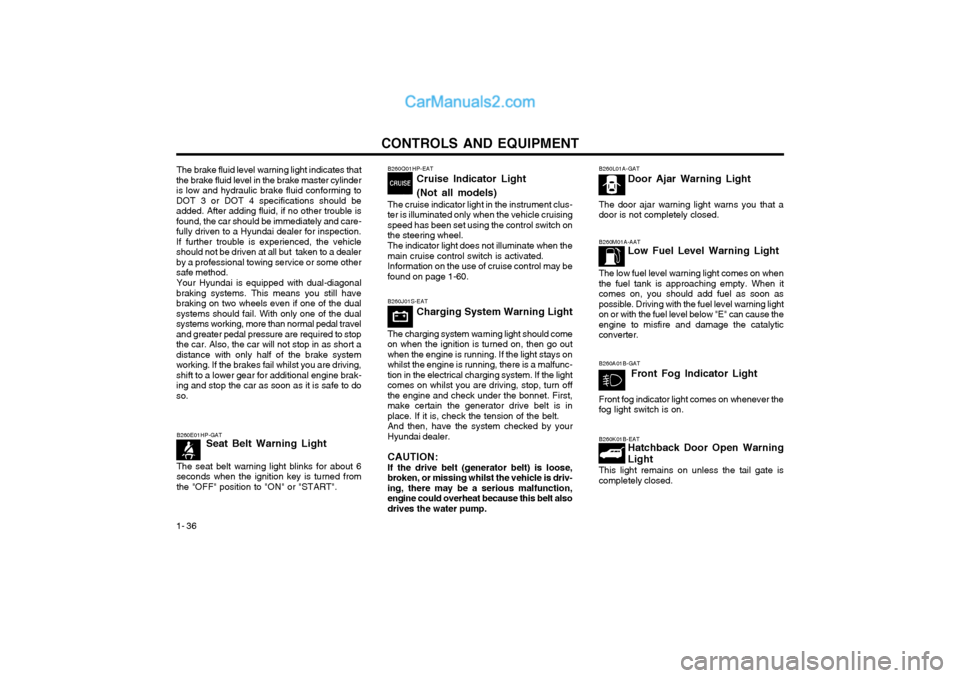
CONTROLS AND EQUIPMENT
1- 36
B260M01A-AAT Low Fuel Level Warning Light
The low fuel level warning light comes on when the fuel tank is approaching empty. When itcomes on, you should add fuel as soon aspossible. Driving with the fuel level warning lighton or with the fuel level below "E" can cause theengine to misfire and damage the catalyticconverter. B260K01B-EAT Hatchback Door Open Warning Light
This light remains on unless the tail gate is completely closed.
B260E01HP-GAT
Seat Belt Warning Light
The seat belt warning light blinks for about 6seconds when the ignition key is turned fromthe "OFF" position to "ON" or "START".
B260L01A-GAT Door Ajar Warning Light
The door ajar warning light warns you that a door is not completely closed.
B260A01B-GAT Front Fog Indicator Light
Front fog indicator light comes on whenever the fog light switch is on.
B260J01S-EAT Charging System Warning Light
The charging system warning light should come
on when the ignition is turned on, then go out when the engine is running. If the light stays onwhilst the engine is running, there is a malfunc-tion in the electrical charging system. If the lightcomes on whilst you are driving, stop, turn offthe engine and check under the bonnet. First,make certain the generator drive belt is inplace. If it is, check the tension of the belt. And then, have the system checked by your
Hyundai dealer.
CAUTION: If the drive belt (generator belt) is loose,
broken, or missing whilst the vehicle is driv- ing, there may be a serious malfunction,engine could overheat because this belt alsodrives the water pump.
B260Q01HP-EAT
Cruise Indicator Light (Not all models)
The cruise indicator light in the instrument clus- ter is illuminated only when the vehicle cruisingspeed has been set using the control switch onthe steering wheel. The indicator light does not illuminate when the main cruise control switch is activated.Information on the use of cruise control may befound on page 1-60.
The brake fluid level warning light indicates that
the brake fluid level in the brake master cylinderis low and hydraulic brake fluid conforming toDOT 3 or DOT 4 specifications should beadded. After adding fluid, if no other trouble isfound, the car should be immediately and care-fully driven to a Hyundai dealer for inspection.If further trouble is experienced, the vehicleshould not be driven at all but taken to a dealerby a professional towing service or some othersafe method.
Your Hyundai is equipped with dual-diagonal
braking systems. This means you still havebraking on two wheels even if one of the dualsystems should fail. With only one of the dualsystems working, more than normal pedal traveland greater pedal pressure are required to stopthe car. Also, the car will not stop in as short adistance with only half of the brake systemworking. If the brakes fail whilst you are driving,shift to a lower gear for additional engine brak-ing and stop the car as soon as it is safe to doso.
Page 233 of 349

CONTROLS AND EQUIPMENT1- 39
B300A01Y-EAT SPEEDOMETER Your Hyundai's speedometer is calibrated in
miles per hour or kilometers per hour. B300A03HP-EB290A02A-EAT COOLANT TEMPERATURE GAUGE WARNING: Never remove the radiator cap when the
engine is hot. The coolant is under pressure and could erupt and cause severe burns.Wait until the engine is cool before remov-ing the radiator cap.
The needle on the coolant temperature gauge
should stay in the normal range. If it movesacross the dial to "H" (Hot), pull over and stopas soon as possible and turn off the engine.Then open the bonnet and check the coolantlevel and the water pump drive belt. If yoususpect cooling system trouble, have your cool-ing system checked by Hyundai dealer as soonas possible.
B280A01A-AAT FUEL GAUGE The needle on the gauge indicates the approx-
imate fuel level in the fuel tank. The fuel capac- ity is given in Section 9.
B280A01HPB290A01HP
Petrol Engine
Reset Knob
B300A01HP-E
Diesel EngineReset Knob
Page 251 of 349
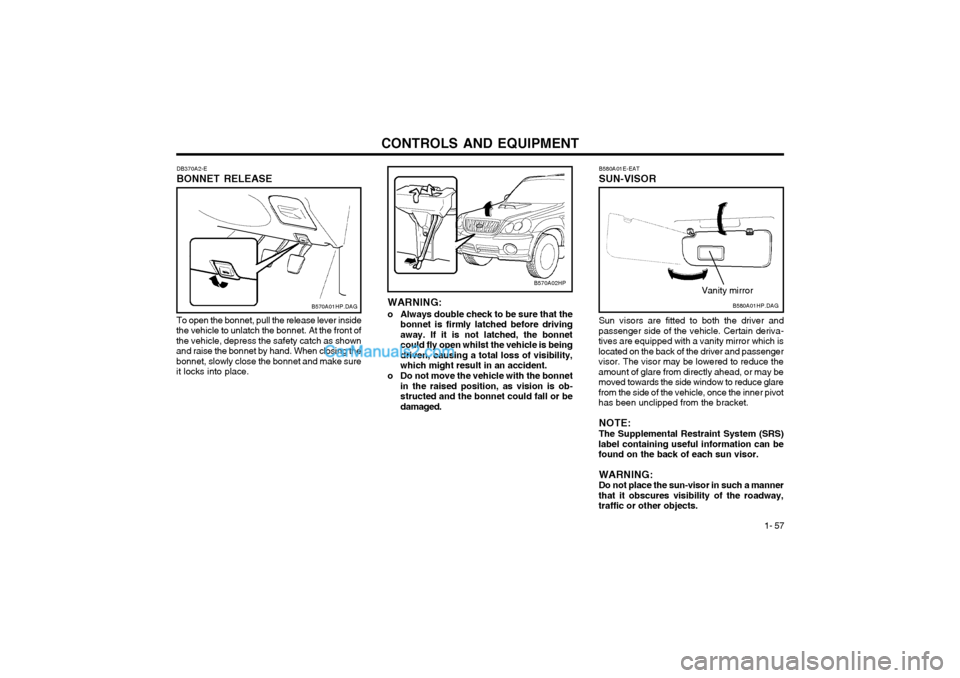
CONTROLS AND EQUIPMENT1- 57
B570A02HP
DB370A2-E BONNET RELEASE
B570A01HP.DAG
To open the bonnet, pull the release lever inside
the vehicle to unlatch the bonnet. At the front of the vehicle, depress the safety catch as shownand raise the bonnet by hand. When closing thebonnet, slowly close the bonnet and make sureit locks into place. WARNING:
o Always double check to be sure that the bonnet is firmly latched before drivingaway. If it is not latched, the bonnetcould fly open whilst the vehicle is beingdriven, causing a total loss of visibility,which might result in an accident.
o Do not move the vehicle with the bonnet in the raised position, as vision is ob-structed and the bonnet could fall or bedamaged. B580A01E-EAT SUN-VISORB580A01HP.DAG
Vanity mirror
Sun visors are fitted to both the driver and
passenger side of the vehicle. Certain deriva- tives are equipped with a vanity mirror which islocated on the back of the driver and passengervisor. The visor may be lowered to reduce theamount of glare from directly ahead, or may bemoved towards the side window to reduce glarefrom the side of the vehicle, once the inner pivothas been unclipped from the bracket.
NOTE: The Supplemental Restraint System (SRS)
label containing useful information can be found on the back of each sun visor.
WARNING:Do not place the sun-visor in such a manner
that it obscures visibility of the roadway,traffic or other objects.
Page 292 of 349
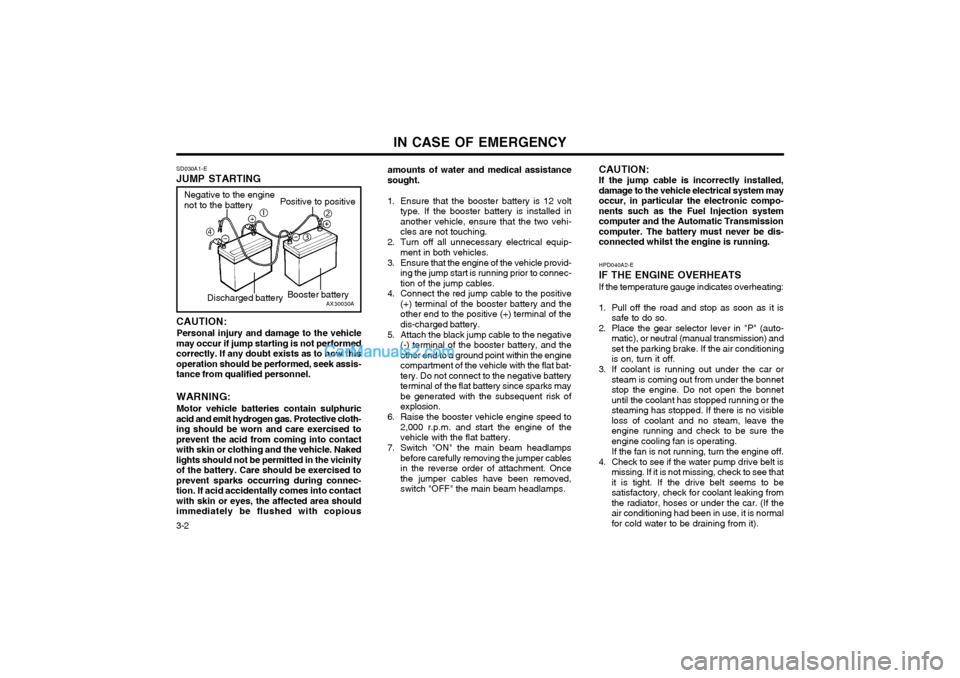
IN CASE OF EMERGENCY
3-2
CAUTION:
Personal injury and damage to the vehicle
may occur if jump starting is not performed correctly. If any doubt exists as to how thisoperation should be performed, seek assis-tance from qualified personnel. WARNING:
Motor vehicle batteries contain sulphuric
acid and emit hydrogen gas. Protective cloth- ing should be worn and care exercised toprevent the acid from coming into contactwith skin or clothing and the vehicle. Nakedlights should not be permitted in the vicinityof the battery. Care should be exercised toprevent sparks occurring during connec-tion. If acid accidentally comes into contactwith skin or eyes, the affected area shouldimmediately be flushed with copious CAUTION: If the jump cable is incorrectly installed, damage to the vehicle electrical system mayoccur, in particular the electronic compo-nents such as the Fuel Injection system
computer and the Automatic Transmissioncomputer. The battery must never be dis-connected whilst the engine is running.
SD030A1-E JUMP STARTING
amounts of water and medical assistance sought.
1. Ensure that the booster battery is 12 volt type. If the booster battery is installed inanother vehicle, ensure that the two vehi-cles are not touching.
2. Turn off all unnecessary electrical equip- ment in both vehicles.
3. Ensure that the engine of the vehicle provid- ing the jump start is running prior to connec-tion of the jump cables.
4. Connect the red jump cable to the positive (+) terminal of the booster battery and theother end to the positive (+) terminal of thedis-charged battery.
5. Attach the black jump cable to the negative (-) terminal of the booster battery, and theother end to a ground point within the enginecompartment of the vehicle with the flat bat-tery. Do not connect to the negative batteryterminal of the flat battery since sparks maybe generated with the subsequent risk ofexplosion.
6. Raise the booster vehicle engine speed to 2,000 r.p.m. and start the engine of thevehicle with the flat battery.
7. Switch "ON" the main beam headlamps before carefully removing the jumper cablesin the reverse order of attachment. Oncethe jumper cables have been removed,switch "OFF" the main beam headlamps. HPD040A2-E IF THE ENGINE OVERHEATS If the temperature gauge indicates overheating:
1. Pull off the road and stop as soon as it is
safe to do so.
2. Place the gear selector lever in "P" (auto- matic), or neutral (manual transmission) and set the parking brake. If the air conditioningis on, turn it off.
3. If coolant is running out under the car or steam is coming out from under the bonnetstop the engine. Do not open the bonnetuntil the coolant has stopped running or thesteaming has stopped. If there is no visibleloss of coolant and no steam, leave theengine running and check to be sure theengine cooling fan is operating. If the fan is not running, turn the engine off.
4. Check to see if the water pump drive belt is missing. If it is not missing, check to see that it is tight. If the drive belt seems to besatisfactory, check for coolant leaking fromthe radiator, hoses or under the car. (If theair conditioning had been in use, it is normalfor cold water to be draining from it).
AX30030A
Negative to the engine not to the battery
Positive to positive
Booster battery
�c
�e
�f �d
Discharged battery
Page 318 of 349

OWNER MAINTENANCE
6-6
To replace the oil and filter, proceed as follows:
1. Ensure that the engine is at normal operat- ing temperature and park the vehicle on level ground with the parking brake securelyapplied and the engine turned off.
2. Open the bonnet and remove the oil filler cap.
3. Prepare a suitable receptacle to collect the displaced oil and remove the drain plug fromthe sump.
CAUTION: The oil being drained from the engine will be
hot. Care should be exercised to prevent scalding.
4. When the oil has drained from the sump, replace the drain plug using a new washer ensuring that the plug is not over tightened. Tightening torque is: 3.5 ~ 4.5 kgf.m
5. Remove the oil filter by rotating counter- clockwise, using a proprietary oil filter re- moval tool if necessary. Note that the oilfilter will contain approximately 0.5 litres ofoil and this should be collected in a suitablereceptacle.
6. Install a new oil filter having smeared the sealing ring with clean oil and rotating clock-wise until the filter contacts the mountingand then a further one half turn. Do not over-tighten. Tightening torque: Petrol Engine - 1.2 ~ 1.6 kgf.mDiesel Engine - 2.3 ~ 2.5 kgf.m
7. Pour the specified quantity of the recom- mended oil into the engine and replace the filler cap. Start the engine and ensure thatno oil leaks exist. Turn off the engine andafter a couple minutes, recheck the oil level.
WARNING: Prolonged and repeated contact with used engine oils may result in serious skin disor-ders including dermatitis and cancer. Avoidcontact with skin as far as possible andalways wash thoroughly after any contact.Keep used oils out of reach of children. It isillegal to pollute drains, water courses andsoil. Use only authorized waste collectionfacilities including civic amenity sites andgarages for the disposal of used oil and oilfilters. If in doubt, contact the local authorityfor disposal instructions. SG050A1-E
ENGINE COOLANT CHECKING AND REPLACING
WARNING: Do not remove the radiator cap when the engine is hot, since the system is pressur-ized and coolant may be ejected from theradiator resulting in scalding. SG050B1-E
Coolant recommendations Only ethylene glycol based coolant with a cor- rosion inhibitor suited to aluminium alloy enginecomponents should be used in the coolingsystem. No further additives or inhibitors shouldbe used. The coolant specific gravity should bechecked as prescribed in the maintenanceschedule to ensure adequate frost and corro-sion protection. In addition, the engine coolantmust be replaced at the specified interval sincethe corrosion inhibitor properties deteriorate withtime. It is important to note that whilst an increase in the concentration of anti freeze gives an in-crease in the level of frost protection, a solutionwhich is in excess of 65% anti freeze will resultin reduced frost protection and engine over-heating. Therefore the recommended concen-tration of 50% should not be exceeded forgeneral use.The use of methanol based anti freeze com-pounds may result in engine overheating andwill invalidate the vehicle warranty.
Page 323 of 349
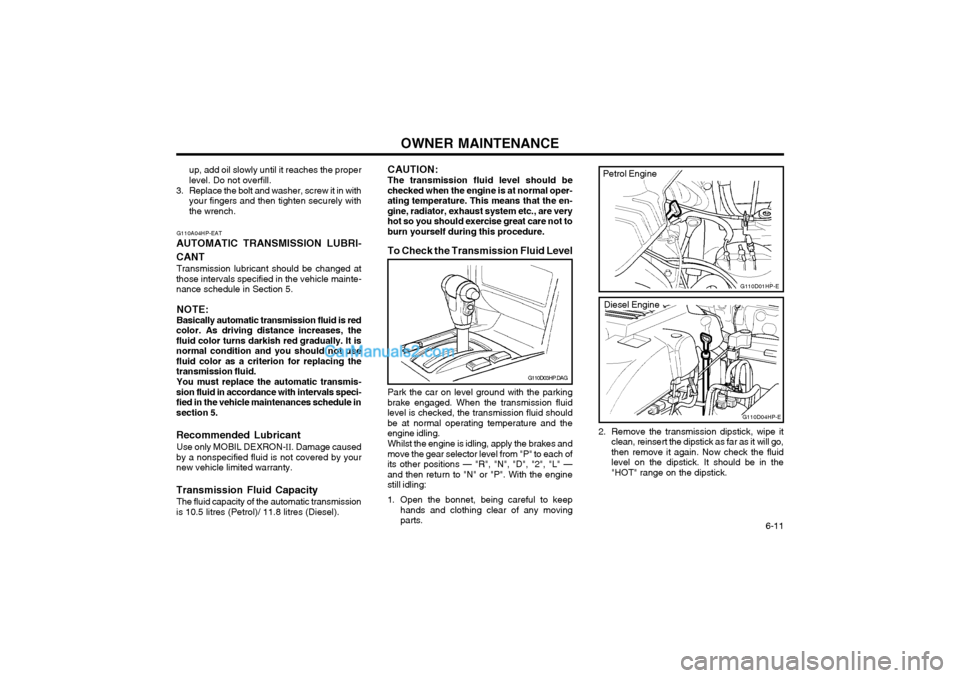
OWNER MAINTENANCE 6-11
G110A04HP-EAT
AUTOMATIC TRANSMISSION LUBRI- CANT Transmission lubricant should be changed at
those intervals specified in the vehicle mainte- nance schedule in Section 5.
NOTE: Basically automatic transmission fluid is red
color. As driving distance increases, the fluid color turns darkish red gradually. It isnormal condition and you should not usefluid color as a criterion for replacing thetransmission fluid.
You must replace the automatic transmis-
sion fluid in accordance with intervals speci-fied in the vehicle maintenances schedule insection 5. Recommended Lubricant
Use only MOBIL DEXRON- II. Damage caused
by a nonspecified fluid is not covered by your new vehicle limited warranty. Transmission Fluid Capacity
The fluid capacity of the automatic transmission
is 10.5 litres (Petrol)/ 11.8 litres (Diesel). CAUTION: The transmission fluid level should be
checked when the engine is at normal oper- ating temperature. This means that the en-gine, radiator, exhaust system etc., are veryhot so you should exercise great care not toburn yourself during this procedure. To Check the Transmission Fluid Level
Park the car on level ground with the parking
brake engaged. When the transmission fluid level is checked, the transmission fluid shouldbe at normal operating temperature and theengine idling.
Whilst the engine is idling, apply the brakes and
move the gear selector level from "P" to each ofits other positions — "R", "N", "D", "2", "L" —and then return to "N" or "P". With the enginestill idling:
1. Open the bonnet, being careful to keep hands and clothing clear of any moving parts.
up, add oil slowly until it reaches the properlevel. Do not overfill.
3. Replace the bolt and washer, screw it in with your fingers and then tighten securely withthe wrench.
G110D03HP.DAG
G110D01HP-E
Petrol Engine
2. Remove the transmission dipstick, wipe it clean, reinsert the dipstick as far as it will go, then remove it again. Now check the fluidlevel on the dipstick. It should be in the"HOT" range on the dipstick. G110D04HP-E
Diesel Engine
Page 325 of 349
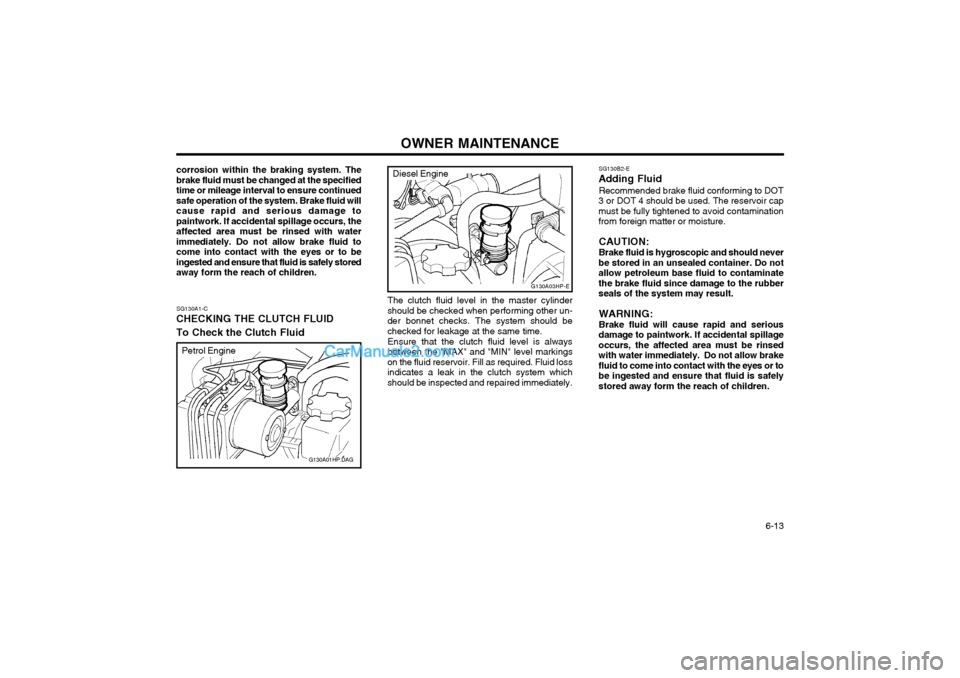
OWNER MAINTENANCE 6-13
G130A01HP.DAG
corrosion within the braking system. The brake fluid must be changed at the specifiedtime or mileage interval to ensure continuedsafe operation of the system. Brake fluid willcause rapid and serious damage topaintwork. If accidental spillage occurs, theaffected area must be rinsed with waterimmediately. Do not allow brake fluid tocome into contact with the eyes or to beingested and ensure that fluid is safely storedaway form the reach of children.
SG130A1-C
CHECKING THE CLUTCH FLUID To Check the Clutch Fluid The clutch fluid level in the master cylinder
should be checked when performing other un- der bonnet checks. The system should bechecked for leakage at the same time.
Ensure that the clutch fluid level is always
between the "MAX" and "MIN" level markingson the fluid reservoir. Fill as required. Fluid lossindicates a leak in the clutch system whichshould be inspected and repaired immediately. SG130B2-E
Adding Fluid
Recommended brake fluid conforming to DOT
3 or DOT 4 should be used. The reservoir capmust be fully tightened to avoid contaminationfrom foreign matter or moisture.
CAUTION: Brake fluid is hygroscopic and should never
be stored in an unsealed container. Do not allow petroleum base fluid to contaminatethe brake fluid since damage to the rubberseals of the system may result.
WARNING: Brake fluid will cause rapid and serious
damage to paintwork. If accidental spillage occurs, the affected area must be rinsedwith water immediately. Do not allow brakefluid to come into contact with the eyes or tobe ingested and ensure that fluid is safelystored away form the reach of children.
Petrol Engine
G130A03HP-E
Diesel Engine